
It’s just a myth that earwigs purposely crawl into the ears of sleeping people and bore into their brains to cause fever and insanity, but these insects still suffer from a bad reputation, probably because of their intimidating appearance. Other than an occasional weak pinch from their ferocious-looking pinchers (if mishandled), earwigs don’t hurt humans. However, they can emit a foul-smelling, yellowish brown liquid from special glands when threatened.
There are many species of earwigs in North America, but the only one found in Wisconsin is the European earwig (Forficula auricularia). This species was first recorded in the U.S. in Rhode Island in 1912 (although it was probably already present in some Western states by then), and has spread throughout the cooler parts of the country, moving into Wisconsin just over the last 25 years or so.
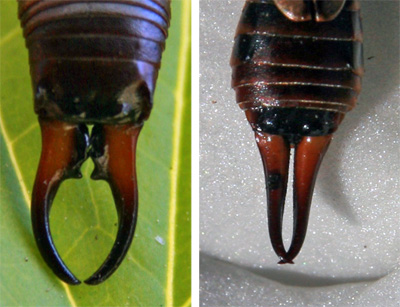
It is an elongated, flat insect, reddish-brown to black in color, and ½ to 1¼ inches in length. The forceps-like appendages at the end of its abdomen are used primarily for defense and during courtship. Females have straight-sided forceps while male forceps are strongly curved and larger. If wings are present, the first pair is hard and short, with a second membranous, fan-shaped pair folded under them, often with the tips protruding.
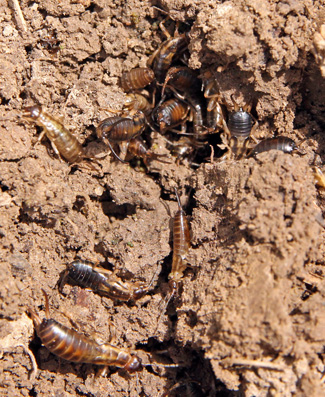
Females lay 50-90 shiny white eggs in a chamber in the ground in the fall. Earwigs may dig as deep as six feet below ground to escape the cold temperatures. They hibernate through the winter in this nest and in the spring attend the first instar nymphs, providing them with food. The young earwigs resemble their parents, but are lighter in color, lack wings and have tiny pinchers. The females generally die before midsummer, by which time the young have left the nest, so numbers tend to decline by August. The young become adults between late August and early October, when new male and female pairs enter the soil to construct their nests.
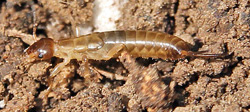
Rich garden soil with a southern exposure is a favorite place for earwigs to lay their eggs. Moist summers tend to favor higher populations. The European earwig has only one specific natural enemy in the United States, a tachinid fly (Bigonicheta spinipennis) that was imported in the Northwest in 1924, but it probably does not occur in Wisconsin.
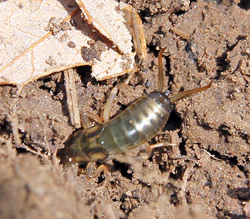
Earwigs feed primarily at night. During the day they hide in dark, moist places such as cracks or crevices, or beneath stones, boards, or debris on the soil surface. They can be found hiding in garden plants, shrubbery, along fences, in woodpiles, at the base of trees, and behind loose boards on buildings. Mulch in flower beds and around trees and shrubs are also great habitats for earwigs.
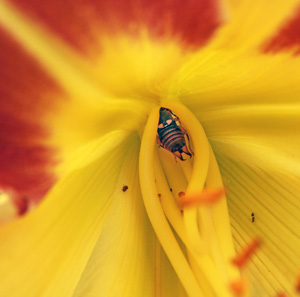
Earwigs are primarily scavengers and will eat just about anything, including both plants and animals. They can actually be considered beneficial insects since they will eat small insect pests and decaying plant materials, although this is generally not sufficient to redeem them in the eyes of most gardeners. Serious feeding damage may occur on the roots and leaves of flowers, vegetables, fruits and other tender, young plants. Some favored plants include clover, dahlias, zinnias, marigolds, butterfly bush, hostas, hollyhock, lettuce, strawberry, celery, potatoes, roses, seedling beans and beets, and tender grass shoots and roots. Earwigs can even damage sweetcorn by feeding on the silks. Their feeding damage looks much like slug damage, as they chew out numerous, small, irregular holes leaving the leaves with a ragged appearance. However, they don’t leave behind a telltale slime trail as do slugs.

While it is chiefly an outdoor insect, its habit of hiding among petals or leaves of plants, or inside fruit, allows it to be brought frequently into the home. Earwigs also come into homes on their own in search of darkness and possibly moisture. They probably get in through small cracks around plumbing pipes or other openings into the house. While it has a varied diet, it probably won’t find much around the house to eat except vegetable waste and therefore probably will not multiply indoors. Once in a house, they will seek shelter in dark, damp crevices, especially in basements, garages, and bathrooms. Indoors, dispose of earwigs as you would any other nuisance household pest – fly swatters and vacuum cleaners work well. Indoor pesticide treatments are not recommended.
When earwigs are causing damage outdoors, control is sometimes necessary. First, check your garden at night with a flashlight to be sure that earwigs really are the culprits. If they are numerous and obviously injuring plants, trapping can reduce numbers and damage.
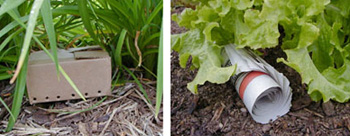
Make simple traps from rolled up corrugated cardboard or newspaper; cardboard tubes or short lengths of hose; pieces of burlap bag, canvas or boards; or even small cardboard boxes with ¼ inch holes punched in the sides near the bottom (and baited with a small amount of oatmeal or bran). Place the traps near damaged plants, or in mulched areas, among shrubs or similar habitats. Earwigs will hide in or under the traps and you can shake them into a pail of soapy water each morning to drown them.
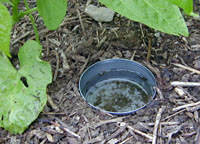
Alternatively, shallow containers filled with vegetable oil or soapy water can be buried up to their rim in your garden, where earwigs, and probably the odd slug or other bug will drown in the liquid.
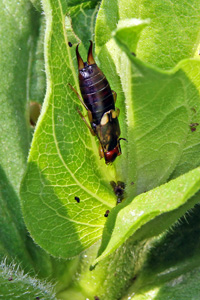
Good preventive maintenance can help reduce outdoor populations and prevent home invasion. Clean up plant debris, loose boards, and other hiding places. Earwigs need and are very attracted to moisture, so eliminate damp, moist conditions around faucets, around air-conditioning units and along house foundations to reduce the likelihood of them entering the house. Seal cracks and crevices, and use caulking compound, putty and weather stripping around doors, windows, pipes and other entry sites, especially at the ground level. Earwigs may be more problematic in homes with mulched areas near entrances, so design your landscaping to create a clean, dry border immediately around the foundation wall. Gravel or ornamental stones can make an attractive barrier against earwigs and other pest invaders.
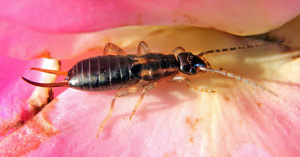
In extreme circumstances, chemical insecticide applications may be necessary. Always be sure to read the label and follow instructions carefully. Apply sprays in late afternoon, if possible, so that residues are fresh when the earwigs become active in the evening. Treat only infested areas to prevent plant damage, but spray around the building foundation and to flowerbeds and turf within a couple of yards of the building to prevent the insects from invading the building. Mulches in such flowerbeds should be treated thoroughly. Use plenty of liquid to achieve good penetration to where the earwigs hide.
– Susan Mahr, Department of Horticulture and Phil Pelletteri, Department of Entomology, University of Wisconsin – Madison
Latest Horticulture News
Ask Your Gardening Question
If you’re unable to find the information you need, please submit your gardening question here:





 Alternatives to Lawn: Groundcovers
Alternatives to Lawn: Groundcovers Marigolds
Marigolds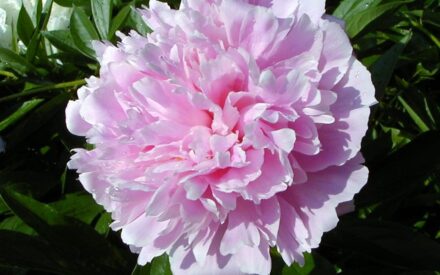 Peony
Peony Iris Severe Mosaic
Iris Severe Mosaic


